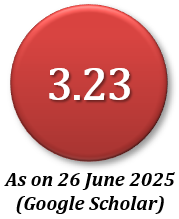Terracotta in Architecture: Overview on Historical and Contemporary Practice in Bangladesh
Abstract
Although Terracotta is one of the oldest in almost all sub-continents and was spread out across the whole world now-a-days it has been a common, traditional, and indigenous object in Bangladesh for everyday life. Inspired by the religion or rituals, terracotta art has evolved in many ways in Bengal over time. From Babylon walls to high-performance rain screens, terracotta claddings have proven repeatedly to be technologically superior and aesthetically rich. Realizing the evolution of terracotta prepares architects to add new, creative chapters to a superior history. Through an extensive inventory of recent examples, project case studies and architectural details, this study provides a foundation for understanding the nature of the material and the opportunities it offers in the urban life. The objective of the paper is to know the evolution of terracotta as a historic, artistic and cultural materials and shapes of objects with aesthetical and technical aspects that plays an important role for place making in both exterior and interior of architectural design and building practice. The paper explores the evolution of terracotta in Bangladesh and prepares architects and builders to make new, creative uses of the timeless material. Validating the examples of expressive possibilities, this precious study can be an inspiration for students and professionals alike who are interested in creating sustainable spaces by using visual and cultural components.
Downloads
References
Ahmed, R., (2021), Banglar mosjide terracotta Alonkoron (in Bengali), stay curious, Siddiquis international school, Dhaka.
Afzal, F., (2018), British Colonial Architecture in Bengal, The daily star ed. Mahfuz Anam, Dhaka.
Ahmed, M. S., (2015), Atiya Mosque at Tangail (Extracted on Dec 17, 2022). Source: https://contextbd.com/atiya-mosque-at-tangail/
Ahmed, N., (1990), Epic Stories in Terracotta - Depicted on Kantanagar Temple Bangladesh, University press ltd, Green road, Dhaka.
B-Property, (2022), History of Terracotta in Bangladesh (Extracted on Aug 16, 2022). Source: https://www.bproperty.com/blog/terracotta-bangladesh/
Banglapedia, (2022), (Extracted on Nov 29, 2022). Source: https://www.banglapedia.org/
Bryk, N. EV, (2022), Pottery in how products are made, Madehow (online version), (Extracted on Sep. 08, 2022). Source: http://www.madehow.com/Volume-4/Pottery.html
Delahunty, A. (ed), (2008), Oxford Dictionary of Foreign words and Phrases, 2nd edition ed., Oxford University press.
Encyclopedia 2018, (2017), (Extracted on June. 07, 2020). Source: https://www.encyclopedia.com/
Free dictionary, Falex, (2022), (Extracted on Jan. 08, 2021). Source: https://www.thefreedictionary.com/
Goswami, Cf.A. (ed.), (1959), Indian Terracottas, Calcutta: Rupa & Co.
Haque, M., (2022), Mural & Terracotta, (Extracted on June 25, 2021), Source: www.mrinalhaque.com.bd
IRB Travel Team, (2022), Darashbari Mosque an Archeological Mosque at Chapainawabganj (Extracted on Dec 02, 2022). Source: https://www.lrbtravelteam.com/darashbari-mosque-chapainawabganj/
Khan, M.H., (1988), Terracotta Ornamentation in Muslim Architecture of Bengal, Asiatic Society of Bangladesh, Dhaka.
Lalgupta, P., (1972), Gangetic Valley Terracotta art. Varanasi: Prethivi Prakashan.
Mahmud, F., (1993) Prospects of Material Folk Culture Studies and Folklife Museums in Bangladesh, Bangla Academy, Dhaka.
Majumder, H.C., (1963), History of Bengal, Vol-I, Dacca: University of Dacca.
Metropolitan Museum of Art, New York, NY (2022), Terracotta Plaque, (Extracted on Dec. 20, 2022), Source: https://www.metmuseum.org/art/collection/search/253053
Naher, K., (2021), Terracotta Mural: A Prehistoric Art Form Fitting Perfectly into Post-Modern Architecture, The Business Standard, ed. Inam Ahmed, (Extracted on Mar 01, 2021). Source: https://www.tbsnews.net/features/habitat/terracotta-mural-prehistoric-art-form-fitting-perfectly-post-modern-architecture
Nijhoom Tours, (2022), Kantaji temple: Bangladesh’s most beautiful Hindu temple wrapped in stunning terracotta (Extracted on Dec 02, 2022). Source: https://nijhoom.com/kantaji-temple/
Rasel, A., (2014), Banglar terracotta, Canvas Magazine, ed. Kanis Almas khan, Dhaka, (Extracted on Apr. 20, 2022). Source: https://www.canvasmagazine.com.bd/2021/04/14/24810
Rashid, M.H., (1977), Geography of Bangladesh, Dacca: University Press Ltd.
Sarwaswati, S.K., (1957), A survey of Indian Sculpture, Calcutta: Firma K.L. Mukhopadhayay.
Schendel, W.V., (2009), A History of Bangladesh, Cambridge University Press
Sharmin, D., A,, R., (2019), Traditional Pottery Industry of Bangladesh: A Case Study on Kakran, Aria and Rayer Bazaar Potter's Villages, Pratnatattya, Journal of the Dept. of Archaeology , Jahangirnagar University, Vol. 25. Pg No?
Shovon, F.R., (2021), International Mother Language Institute: A Failed Enterprise, (Extracted on Nov 28, 2022), Source: https://archive.dhakatribune.com/special-supplement/2021/02/21/international-mother-language-institute-a-failed-enterprise
Tanim, F.K., (2011), Hope rekindles for terracotta art in Bangladesh, The Independent, Weekend Magazine, ed. M. Shamsur Rahman.
Tiller, T.P., (2004), The preservation of historic architectural glazed terracotta, in The preservation of Historic Architecture, The US Government official guidelines for preserving historic homes by Department of Interior,The Lyons press, Connecticut, USA.
Topadar, M., (2020), terracottar Sporsho (touch of Terracotta), chitrakotha (online version), (Extracted on Sep. 08, 2022). Source: https://kolkataculture.wordpress.com/2020/09/14/টেরাকোটার-স্পর্শ/
Tunick, S., (1997), Terra-cotta Skyline: New York's Architectural Ornament, Princeton Architectural Press, USA.
Vats, M.S., (1940), Excavations at Harappa, Vol 01, Calcutta: Govt. of India press.
Wikimedia, (2015), (Extracted on Nov 07, 2021). Source: https://commons.wikimedia.org/wiki/File:Struggle_for_Independence_-_Terracotta_Mural_-_Museum_of_Independence_Wall_-_Suhrawardy_Udyan_-_Dhaka_2015-05-31_2199.JPG
Wikimedia, (2007), (Extracted on Dec 02, 2022). Source: https://commons.wikimedia.org/wiki/File:টেরাকোটার_সন্ধানে_(_Terracotta_of_Paharpur),Naogaon,BD.jpg
World Heritage Site, (2012), The Lalmai-Mainamati Group of Monuments, (Extracted on Dec 02, 2022). Source: https://world-heritage collection.blogspot.com/search?q=mainamati
MIJST follows the open access policy.

This work is licensed under a Creative Commons Attribution-NonCommercial 4.0 International License. This allows anyone to copy, share, distribute, and modify the work for non-commercial purposes, where the original work and source should be properly credited.
















